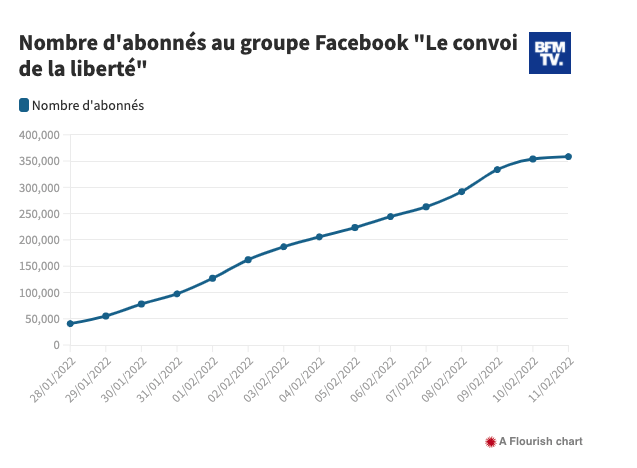Sommaire
Freedom Convoys: A Successful Rebranding of Anti-Vaxxers
For the past week, the media have been watching a phenomenon imported from Canada, wondering if it’s a new "Yellow Vests" movement. In doing so, they are inadvertently amplifying a phenomenon that mostly resembles a rebranding of anti-vaxxer communities.

Analysis via Brandwatch
A classic spread
The spread began with:
1. Coverage of the movement in French-speaking Canada by local media and some politicians.
2. Anti-vaxxer movements and those close to Philippot (Trump France, BLF.TV) identified the movement and hoped for its spread to France. Russia Today even wrote an article about it.
3. The movement gained traction on Facebook, growing from 40,000 members on January 28 to 360,000 on February 11.(Facebook later announced it had removed accounts: "In France, as in other countries, we have removed groups, personal accounts, and pages related to these protest movements for violating several of our platform rules, particularly for spamming and misleading people to monetize their interest in the movement.")
4. The media picked up the "buzz" via 24-hour news channels (BFM, Cnews).
5. Other opposition groups joined the movement.
6. Mainstream media began covering it.
7. Opposition politicians started claiming the movement as their own.

Yellow vests and freedom convoy: The same fight?
Quickly, comparisons were drawn with the Yellow Vests. However, the parallel is not straightforward since the spread is not identical.
The Freedom Convoy has been circulating in conversations for a while, thanks to Canada. Moreover, we don’t have access to Facebook data to compare statistics.
Only Twitter, by analysing the growth of conversations using volume curves:

We can see that the Freedom Convoys had a more solid starting point, but took longer to emerge.
Additionally, weekend peaks don’t follow the same patterns. However, there are some starting similarities:
A rapid emergence on Facebook. Facebook groups have created new forms of mobilization that weren’t seen before the Yellow Vests. Since then, protest networks have become well-established communities. It’s easy for someone with a history of protest (Yellow Vests, Red Caps, Nuit Debout, etc.) to have formed connections with others through these movements. These networks are now easily remobilized for new causes.
A movement without clear demands, allowing the broadest possible participation. This makes it possible, as with the Yellow Vests, for people from both the far-left and far-right to unite around common narratives, with the rejection of Emmanuel Macron and the government being the main one.

Key deployed terms show that the vaccine issue (vaccine passes, vaccines) is a central concern.
The state's response, with over 7,000 law enforcement officers, also sparked conversations around words like “armored vehicles,” “tanks,” or “Lallemant.”
Lastly, the Yellow Vests are mentioned, either in hashtags or specific discussions.
So the question is: Is this a Yellow Vests movement or a continuation of the anti-pass protests?
By analyzing the authors of conversations around the Freedom Convoy and those using anti-pass hashtags (#passdelahonte OR #nonaupassdelahonte OR #pfizergate), we find very similar audiences, differing mainly in the media they engage with.

Conclusion
It’s clear that digitally, the anti-pass audience and the Freedom Convoy audience are the same.
Is this true for real-life participants?
One doesn’t preclude the other, but what’s certain is that the rebranding of the protest has allowed for a narrative more focused on the concept of freedom and opposition to power, which has garnered more support than previous anti-pass protests. This indicates that the rebranding has been effective!
Photo credit: Shutterstock




